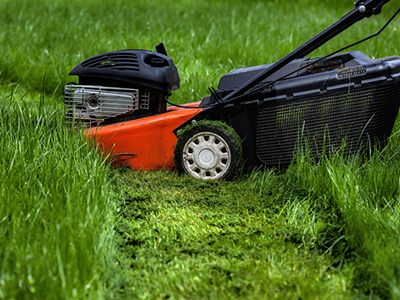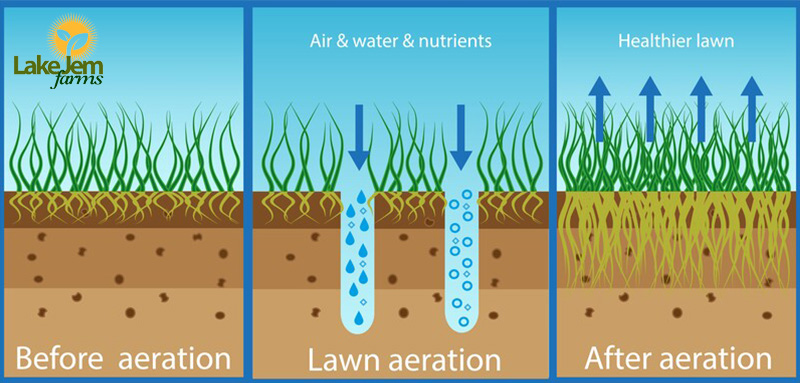Aeration, simply put, is the process of allowing air or oxygen as well as water and fertilizers (nutrients) to reach the roots of your sod by putting small holes in your lawn. When the soil becomes compact the roots of your grass will not easily get the nutrients it needs and will suffer.
What causes the soil to compact? Over time, walking, playing, rolling your lawnmower over it and even rainfall will all play a role in compacting the soil. If the soil gets too compact the roots become restricted and will certainly spell doom for your lawn and heartier weeds will take over. As you know, weeds seem to grow everywhere and under any condition. The healthier your lawn is the lees likely there will be room for weeds to flourish so you need to occasionally aerate your lawn.
The aeration process is basically putting holes throughout your lawn to break up the soil and provide a way for the roots to get water and nutrients. There are different tools you can use to aerate your lawn.
- Hand Aerators – For really small lawns you can use a Hand Aerator. It’s a rake-like looking device that has a few spikes on the bottom about 4 or 5 inches apart and 3 to 4 inches long. You use your foot to drive it into the ground. It will sufficiently break up the soil and allow nutrients to reach the roots. A hand aerator works pretty well but requires a lot of effort because it only covers a small area. So, if you have a small lawn this might be an option.
- Aerator Shoes – Aerator shoes are another inexpensive way to aerate your Central Florida sod. They aren’t shoes per se but strap on to the bottom of your shoes and you can even wear them when you mow the yard, although it might be a bit cumbersome. The bottom has spikes that are a few inches long which will create holes in the soil and sufficiently aerate your lawn. Shoes are much easier to use to cover a small to medium-sized yard without the energy required of the hand aerator option.
- Rolling Aerators – These are pretty much like the name sounds. Rolling aerators have spikes that are attached to a cylindrical device that rolls across the yard. This makes the aerating process much easier and faster. They do make hand rolling aerators where the spikes are attached around a thick rod. However, they are small in width and you won’t be able to cover much ground per pass. Most rolling aerators are spikes attached to what looks like a barrel on its side. They are around 36 to 48 inches wide or more, heavier and have a little longer spikes making it easy to penetrate deep into the soil and can cover much larger areas. Of course, these are too big and heavy to push around by hand but perfect to tow behind a riding mower or similar type of machine.
- Plug Aerators – Plug aerators provide the best aeration for your yard. Instead of spikes, they are sharp hollow rods that penetrate the ground and pull out plugs about a half an inch in diameter and 3 inches long. This provides a more direct and efficient way for your sod to get and hold water, air, and nutrients. It also provides more room for roots to grow. The plugs should be left in the yard because they will provide nutrients back to the soil. Don’t worry, they will dry up and disappear in a couple of days or you can simply mow over them. Plug aerators are much like rolling aerators in design, about 48 inches wide, and can be towed behind a riding lawn mower or tractor. Pro Tip: Plug aerators do not work well if the ground is too hard and dry. They work best if you wet your yard a day before you aerate.
How Often And When Is the Best Time To Aerate you Lawn?
Typically, you should aerate once in the spring and once in the fall. Even if your soil doesn’t become too compacted, aeration is good to cut through any thatch build up in your lawn. If you do it only once a year spring is the best time.

If your grass is high, it’s better to take a bit off at a time. No more than about a third of the grass blade height and bag your clippings. Then give it a couple of days and mow it again to bring it down to an appropriate height. Although the natural mulch of grass clippings is generally good, if it’s too long or there is too much of it, it can clump and smother your lawn denying it of sunlight and its ability to absorb the nutrients. If you are faced with this situation and you don’t have a bag on your mower, you can use a blower after you mow to remove the excess from your lawn.
It’s also important to mow your grass when it is dry. Wet grass will easily clump and cause the same problems as grass clippings that are too high or thick. One last tip: keep your mower blade sharp. A clean cut on the top of your lawn as opposed to being ripped off by a dull blade is not only healthier for your lawn but will keep it looking better and prevent clumping.
So, If you were thinking that not bagging your lawn clippings was lazy, it’s not. It’s actually smart and better for making your lawn green, beautiful, and the envy of your neighbors. All you have to do is mow regularly and maintain your mower.

